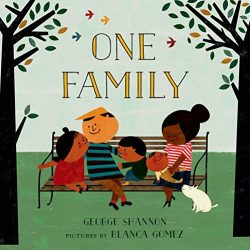One Family
One Family: Overview and Description

Plot
This story is a diverse and inclusive take on a counting book, focusing on the idea that one may also be many. Each page shows the concept of one–one family–but also shows the size of these families increasing from one to ten and then to everyone. Each illustration pairs a set of objects–bananas, flowers, laundry, bears, pears, keys–with the number of people in one family, all within the backdrop of an urban setting.
Math Practice (Asking Questions)
What is ONE? Can ONE be many things?
When might ONE be two? When it is one pair of shoes! When might ONE be seven? When it is a flock of birds flying in the formation of 2+2+2+1! When might ONE be inclusive and expansive? When it is ONE earth, one world, one family!
This story is a powerful opportunity to consider, and reconsider, ONE-ness. One can be many things. When children have opportunities to think more expansively about ONE, new questions emerge. This book affords opportunities to prompt children to share their questions, linger before turning a page, and pause where you notice their energy rising or their focus deepening. You might ask, “What do you notice?” or “What do you wonder?” You may share some of your noticings and wonders, too.
For example, a child might squint and glance closely in order to count the butterfly’s legs (in the illustration on the pages “One is six”). You may ask, “What do you wonder?” “What questions do you have?” “How is it true that ‘one is six’?”
Math Content
There are always opportunities to explore math content in stories. For example, in this book, there are many opportunities to think about ONE. As you enjoy this story with children, invite them to count anything and everything in the illustrations. Invite them to reason aloud about how ONE can be so many things! Invite them to count in their world around them (whether you are outside or inside) and identify sets of ONE. Offer supplies, like plain paper and markers to invite them to illustrate their own set of ONE and count aloud as they draw.
Read Alouds: Let’s Read Together
Try one (or all) of the three read alouds provided below.
Open Notice and Wonder Read
Enjoy a first read where you follow children’s interest, pausing where there is energy to ask, “What do you notice?” and “What do you wonder?” In this story, children will tend to count the number of people and to look for the corresponding objects (keys, bears, flowers), which can at first seem somewhat hidden. Celebrate hearing children’s ideas and questions!
Math Lens Read
A math lens read can go back to revisit what children noticed and wondered mathematically during the first read. You may or may not read entirely through or perhaps jump to focal parts of the story to think as mathematicians. For example, to think about the math practice of asking questions, you might say, “You had many wonders in our first read. You wondered how many legs were on the butterfly. You counted 1, 2, 3, 4, 5, 6 legs. One set of butterfly’s legs! When you look around us (glancing up from the pages to your surroundings), where do you see 6 around us? Where else might six be ONE in our world?”
Story Explore Read
A story explore read can go back to revisit what children noticed and wondered about the story during the first read! You might read the story again, or perhaps you might jump to focal parts of the story to think as readers. Since this book has a sequence of numbers 1-10 rather than a plot, revisiting favorite pages works well. For example, you might say, “On this page it says, ‘One is four. One ring of keys. One pile of pups. One family.’ What do you notice happening in the illustrations? Who are these people and what are they doing? Why do you think so?” You might also make a math lens connection by asking about the number four and how it is represented in this illustration.

